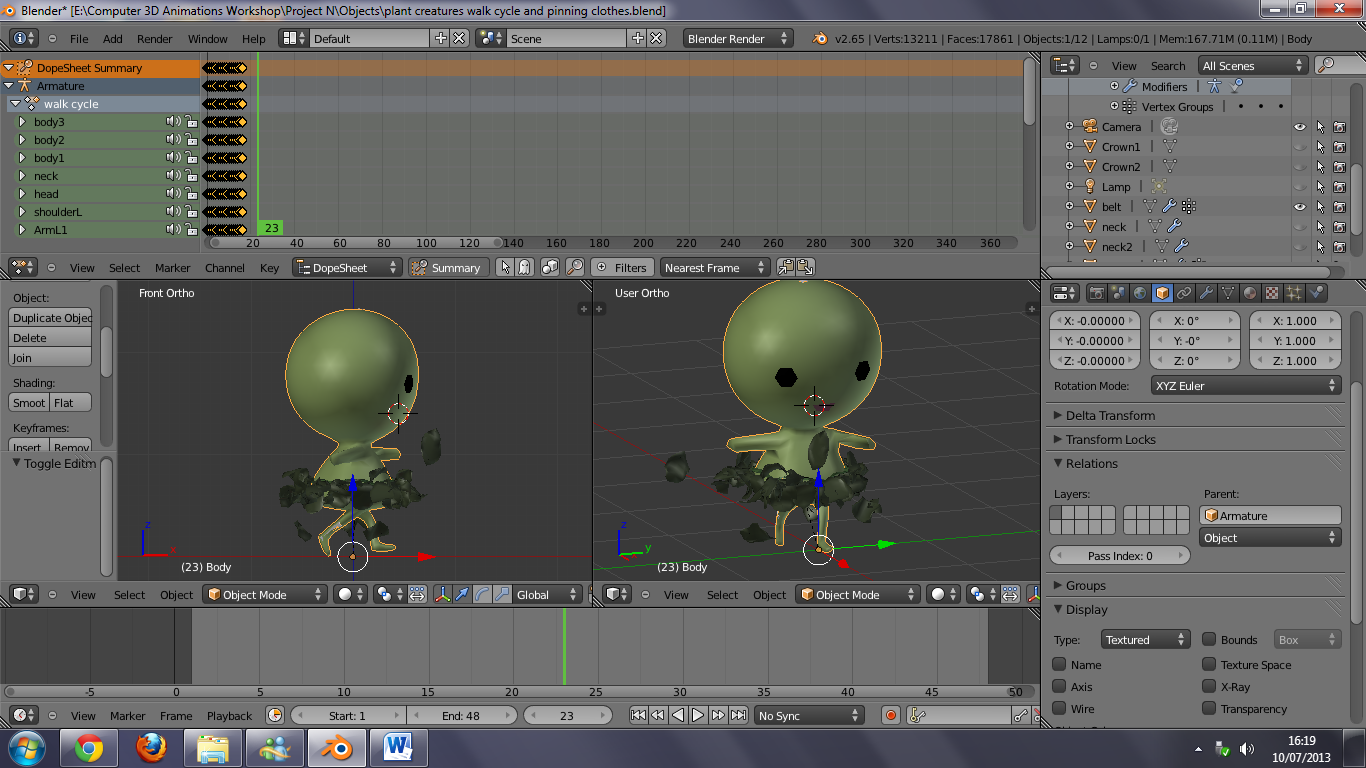To take part in one of the 3Dami summer studios a student must submit a (small) portfolio. A portfolio is simply one or more works intended to represent a students capabilities (artistic and/or technical). Portfolios are required to get jobs in industry, so creating one is great practise as well as an invaluable learning experience. For 3Dami a portfolio proves to us that you are enthusiastic about coming, and also demonstrates that you have learnt the basics of the software we use.

Part of a successful portfolio by Amy
Our software of choice is Blender, and it is very easy to get started using it, not to mention entirely free. We’d suggest:
- Register your interest for 3Dami.
- Download Blender (It’s free! If you’re a Steam gamer its also available on Steam.)
- Complete at least one beginners tutorial series:
- 3Dami Blender Basics – Our own tutorial series, designed to be very easy to follow for absolute beginners. Does not go deep enough however, so you will need to do further work before attending. Think of it as an easy start before you tackle one of the other two tutorial series.
- Grant Abbitt Basics – More detailed than above, but will also take you longer. lots more tutorials by Grant here.
- Blender Guru – much slower, but will get you making pro level work. Lots more tutorials by Andrew here.
- For those of you into 2D animation, check out Blender’s grease pencil.
- Work through two or more tutorials (see below).
- Submit your portfolio before the deadline for feedback, via Email.
- Make changes (potentialy to multiple rounds of feedback) and submit via Email.
- You may want to look at previous applicant’s submissions.
Anything can be submitted as part of a portfolio: Images, videos, 3D content, computer games, even creative writing, created using any method (any software and/or any traditional method, such as pencil sketches or paintings. These will need to be scanned into the computer.). We do require that portfolios include at least one work created with Blender, our software of choice. This is to ensure you arrive with some understanding of how to use it, so we can focus on the more advanced skills required to make a film. When multiple software packages have been used to create a portfolio we will need to know which software was used for each work. A portfolio may include group work, but we will need to know which bits you created.
Absolute beginners are accepted. It is entirely possible to create a good portfolio with only a single days worth of work, where Blender is used for the very first time. Teamwork is part of the event, and we endeavour to select students with complimentary skills, so demonstrating variety is important. Most applicants fail to get on for the simple reason that they never put in the effort to make and submit a portfolio (over 3/4 of applicants). Of those that do submit a portfolio a lack of originality is the most common weakness – submitting the output of several tutorials, if done well, may be enough, but we advise students to include at least one piece of work (Blender or otherwise) that they did for their own enjoyment. Responding well to feedback on work in progress is one of the main predictors to getting on to the course, so please send work through when you can.
Tutorials
There are many places you can start to learn (online tutorials, books etc.). Each student should choose and do at least 2 tutorials. The output from these tutorials can go into their portfolio. 3D modelling, texturing/materials, creating (rigged) characters and animation are all key parts of making a film, and we always aim to have at least one student in each team who has demonstrated an ability to do each – it is highly beneficial to include at least one of these in your portfolio. Be warned that creating a character from scratch is incredibly hard – start small and work your way up to it.
Here are a number of websites where good quality free tutorials may be found:
b3d101.org – Tutorials for absolute beginners; includes the 3Dami tutorials.
blenderguru.com – These tutorials are very easy to follow, once you have the basics down, and well suited to a beginner. Not as advanced as some of the other sites, but much easier to follow.
cgcookie.com – A wide variety of polished tutorials, covering the basics through to the advanced. There are also paid tutorials, but the free ones are more than enough.
blenderdiplom.com – Tend to be more technical, but some great stuff for the more technically minded.
cgmasters.net – Most of their stuff is paid for, but their free section is still large, and has a good selection of easy to advanced.
creativeshrimp.com – Gleb is a spectacular artists, and his tutorials are aimed at a very high level – somewhere to go when you are after ideas and tricks to become a master.
Further Tutorials
None of the below are about Blender; instead they are about film making in general, and other skills that may prove valuable:
ctrlpaint.com – Before you make a gorgeous 3D model or character you should create concept art. This website focuses on digital 2D art, and may help with the preparation that comes before you start working in Blender.
Every frame a painting – A brilliant series of video essays about film making.
fxguide.com – Has loads of breakdowns of film VFX, and explains how they were done.
nofilmschool.com – A news website about film making in general. Can be a great source of inspiration, as it regularly dives into the details of everything from short indie films to major blockbusters.
